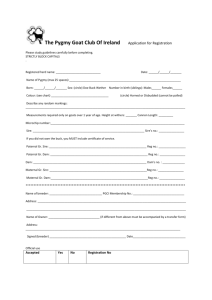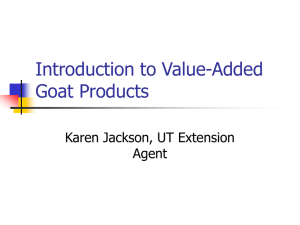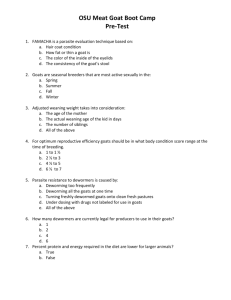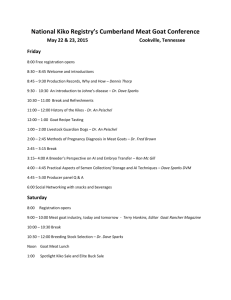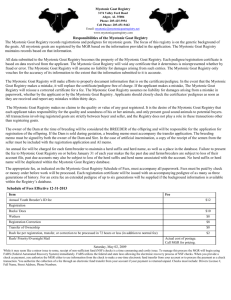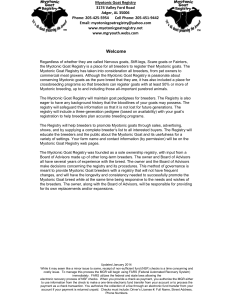MGR Registration Form Instructions
advertisement
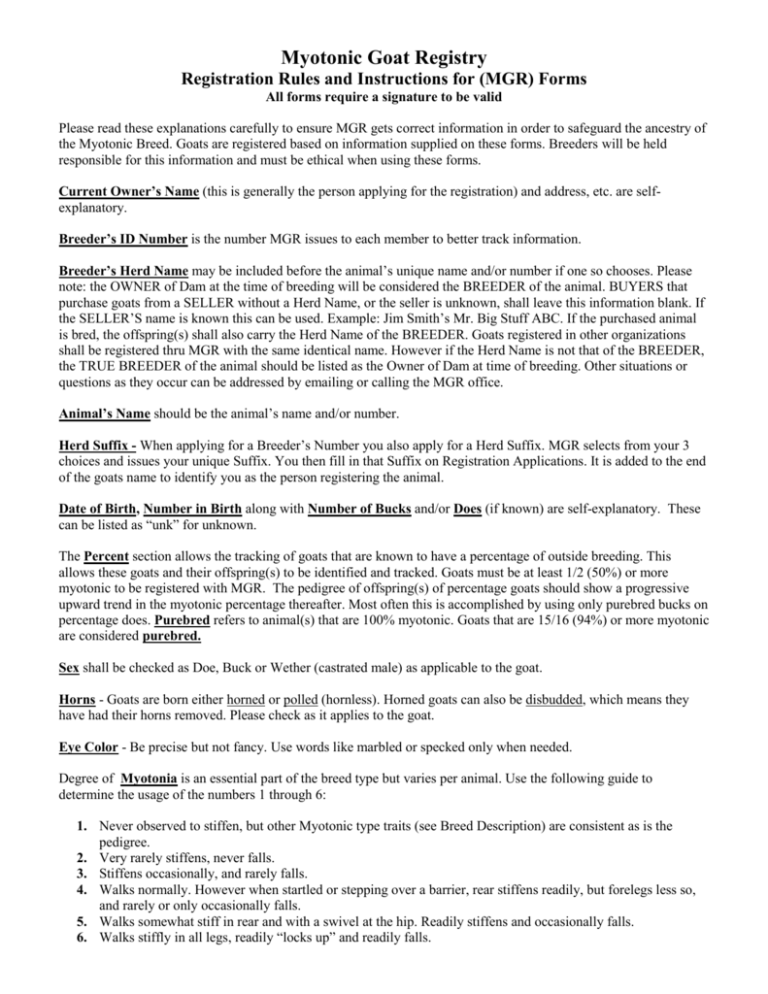
Myotonic Goat Registry Registration Rules and Instructions for (MGR) Forms All forms require a signature to be valid Please read these explanations carefully to ensure MGR gets correct information in order to safeguard the ancestry of the Myotonic Breed. Goats are registered based on information supplied on these forms. Breeders will be held responsible for this information and must be ethical when using these forms. Current Owner’s Name (this is generally the person applying for the registration) and address, etc. are selfexplanatory. Breeder’s ID Number is the number MGR issues to each member to better track information. Breeder’s Herd Name may be included before the animal’s unique name and/or number if one so chooses. Please note: the OWNER of Dam at the time of breeding will be considered the BREEDER of the animal. BUYERS that purchase goats from a SELLER without a Herd Name, or the seller is unknown, shall leave this information blank. If the SELLER’S name is known this can be used. Example: Jim Smith’s Mr. Big Stuff ABC. If the purchased animal is bred, the offspring(s) shall also carry the Herd Name of the BREEDER. Goats registered in other organizations shall be registered thru MGR with the same identical name. However if the Herd Name is not that of the BREEDER, the TRUE BREEDER of the animal should be listed as the Owner of Dam at time of breeding. Other situations or questions as they occur can be addressed by emailing or calling the MGR office. Animal’s Name should be the animal’s name and/or number. Herd Suffix - When applying for a Breeder’s Number you also apply for a Herd Suffix. MGR selects from your 3 choices and issues your unique Suffix. You then fill in that Suffix on Registration Applications. It is added to the end of the goats name to identify you as the person registering the animal. Date of Birth, Number in Birth along with Number of Bucks and/or Does (if known) are self-explanatory. These can be listed as “unk” for unknown. The Percent section allows the tracking of goats that are known to have a percentage of outside breeding. This allows these goats and their offspring(s) to be identified and tracked. Goats must be at least 1/2 (50%) or more myotonic to be registered with MGR. The pedigree of offspring(s) of percentage goats should show a progressive upward trend in the myotonic percentage thereafter. Most often this is accomplished by using only purebred bucks on percentage does. Purebred refers to animal(s) that are 100% myotonic. Goats that are 15/16 (94%) or more myotonic are considered purebred. Sex shall be checked as Doe, Buck or Wether (castrated male) as applicable to the goat. Horns - Goats are born either horned or polled (hornless). Horned goats can also be disbudded, which means they have had their horns removed. Please check as it applies to the goat. Eye Color - Be precise but not fancy. Use words like marbled or specked only when needed. Degree of Myotonia is an essential part of the breed type but varies per animal. Use the following guide to determine the usage of the numbers 1 through 6: 1. Never observed to stiffen, but other Myotonic type traits (see Breed Description) are consistent as is the pedigree. 2. Very rarely stiffens, never falls. 3. Stiffens occasionally, and rarely falls. 4. Walks normally. However when startled or stepping over a barrier, rear stiffens readily, but forelegs less so, and rarely or only occasionally falls. 5. Walks somewhat stiff in rear and with a swivel at the hip. Readily stiffens and occasionally falls. 6. Walks stiffly in all legs, readily “locks up” and readily falls. USDA Scrapie Tag #, General Tag #, Microchip #, and/or Tattoos should be filled in as applicable to the goat. MGR does not require a tattoo or scrapie tag, nor does it require a microchip, or general ear tag. However, the USDA has mandated that all goats moved from the owner’s property must have a scrapie tag, or in the case the animal is registered, a tattoo with a copy of the registration papers accompanying the animal. Some states allow microchips in place of scrapie tags and/or tattoos. You should check with your state and the state of destination for requirements about transportation and Scrapie rules. The Myotonic Line (optional) helps to identify the different branches of the Myotonic Goat family tree. If a goat is known to have only Tennessee breeding, check Tennessee. If a goat has only Texas breeding, then that should be checked. Goats that are bred specifically for small size should be noted as Mini. Many goats are a combination of these branches, and in that case leave this blank. Hair length (optional) varies within the breed and though this is an optional section it helps to better identify the goat. Short hair is short in length, generally laying flat against the body producing a smooth coat. Medium hair is medium in length, generally flows from the body as opposed to lying flat. Long hair is long in length and flows downward from the body; and often times the hair nears the ground. Skirted is used to describe goats that have much longer haired areas, generally around the front and/or back legs. Can be checked as applicable to the goat. Color and Description - Be complete but not overly detailed. It is useful to list the colors present somewhat in the order of their amount. A goat that is “black, tan and white” and a goat that is “white, red and black” are both tricolored goats, but look very different. The goal is to reflect the goat’s overall coloration. Sire’s and Dam’s Registered Names are self-explanatory. Their MGR Registration Number must be filled in along with the name. All bucks/bucklings must have 2 MGR registered parents (Sire and Dam) to qualify for Registration. A buck/buckling can NOT be registered if both parents are not registered with the Myotonic Goat Registry. Owner of Sire and Dam are self-explanatory, but please use the persons name not Herd Name. The photograph provides additional information to help identify the goat. The goat being registered must appear clearly in the photo with the most identifiable side of the goat shown. A photo with a fence in front of the goat should not be used. The photo should be approximately 2 ½“ x 2 ½“ or smaller to fit the Registration Certificate. If using digital photography and printing them yourself use quality photo paper in gloss or semi gloss to retain image clarity for many years. When selling a registered goat the Registration Certificate and a Transfer Application must be furnished the buyer with all appropriate memos attached. The original Registration Certificate must be returned to MGR in order for a new certificate to be issued. When selling a bred doe, a Breeding Memo with the Breeder/Seller’s signature must be supplied with the Transfer Application. If the Sire at time of breeding is owned by someone other than the Owner of Dam, a Service Memo with the signature of the Owner of Sire shall also be included. When artificial insemination is the form of breeding an AI Memo signed by person performing the AI should be furnished. Deceased goats When you have a MGR registered goat die, please email, call, or write MGR with notification. This will help maintain a more accurate database. Please include the goat’s Registration Number and date of death (if known) with your correspondence; we do not require the return of the Registration Certificate.

